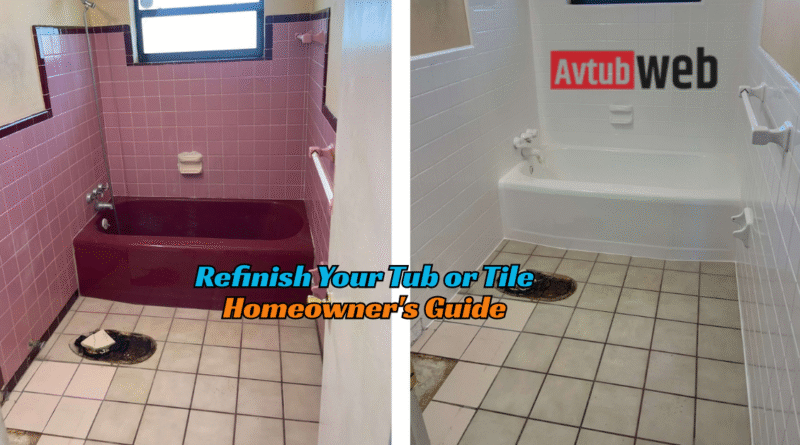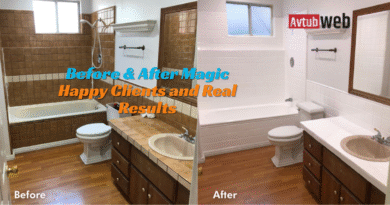Refinish Your Tub or Tile in Southern California: A Homeowner’s Guide
If you live in Southern California and are thinking about refinish your tub or tile, this guide, What Every Homeowner Should Know Before Refinishing Their Tub or Tile in Southern California, will walk you through all the major points. You’ll learn when refinishing makes sense versus replacing, how to check if your surface is sound, which materials are compatible, the key questions to ask a provider, what the process involves, how long it takes, how to avoid common problems, what warranties you should expect, how to look after your new finish, and finally how to pick a provider you can trust.
When Refinish Your Tub or Tile is appropriate — vs when replacement is needed
Refinishing is a good choice when the structure beneath your tub or tile is solid—no major leaks, no cracks going right through, and the plumbing is working properly. If the tile backing is rotten, the foundation has shifted, or you want to change the shape or layout of the bath area, replacing may be the smarter move. Industry data show refinishing a tub usually costs between about $335 and $630. By contrast, full replacement can run into thousands of dollars. If you inspect your area and find rust, holes, major cracks, or movement in the structure, replacement may be the safer route.
Material types & compatibility: porcelain, fiberglass, acrylic, tile
Different materials respond differently to refinishing. For older homes, porcelain or enamel tubs are common, and many fall in the $350-$600 range. Fiberglass tubs are harder to refinish because of their surface properties; costs may be higher. Acrylic also needs special treatment and may run $400-$700 or more. Tile surrounds and floors can be refinished too — re-grouting, sealing, or resurfacing — but only if the backing board and substrate are in good shape. If the tile is loose, the grout is missing, or the backing is water-damaged, then replacement of the tile substrate may be required. Make sure your contractor has experience with your specific material type.
Questions to ask your refinishing contractor
Before you commit, ask your provider specific questions: How many years have you done this kind of material (porcelain, fiberglass, tile)? Which coatings do you use, and what are the VOC levels or warranty on those products? What surface preparation is included — are chips or cracks repaired, is masking done, is proper etching or sanding part of the job? What is the timeline, and when will the bathroom be usable again?
What warranty do you provide on the finish? How do you protect adjacent surfaces like floors and walls from overspray or damage? Do you have before-and‐after photos of similar local projects? What maintenance instructions will you provide after the job? Are any hidden costs possible if you find substrate damage during work? Are you licensed and insured for this type of refinishing work in our area? Clear answers to these questions are a sign you’re dealing with an experienced provider.
You can learn about the expected timeline and when your bathroom will be usable again through this bathroom refinishing guide.
What the process involves: surface prep, coating, curing
The refinishing process starts with surface preparation: this means cleaning the fixture, sanding or etching the surface so the new coating will adhere, repairing chips or cracks, and masking off surrounding areas. Some industry estimates say proper prep makes up around 98% of whether the job turns out well. After prep comes the coating application: usually a high‐adhesion primer, followed by a durable top coat like epoxy or urethane. Then comes curing: the fixture must be left to harden for a set period—commonly 24-48 hours—to let the finish set properly.
Finally, there should be a final inspection of the finish quality, plus written instructions for maintenance and warranty documentation. A good provider will walk you through each of these steps up front.
How long does it take, and when can you use your bathroom again
Most refinishing jobs in Southern California can be completed in one to two days, depending on the scope of work. During that time, you may not be able to use the bathroom, and after the coating is applied, you may need to wait a full cure period (often 24-48 hours) before using the tub or shower again. By contrast, a full remodel often takes days or weeks and may require you to arrange alternate bathroom use.
Common pitfalls and how AV Tub avoids them
Some common mistakes that homeowners face: poor surface p, which leads to peeling or bubbling later; hidden damage in the substrate that was never addressed, causing failure down the line; and lack of a solid warranty or follow-up support. A reliable company will document the condition of the surface before work, will give realistic scheduling, will use high-quality coatings, and will focus on follow-up maintenance instructions. Avoid providers who give vague answers about the prep process, who treat all jobs the same regardless of material or damage, or who won’t provide a written guarantee.
Warranties & guarantees: what you should expect
A professional refinishing provider often offers a written warranty covering issues like peeling, bb, bling, or adhesion failure for one to three years, depending on the conditions. Ask exactly what the warranty covers: is it transferable if you sell your home? Are there exclusions — for example, damage from improper cleaning or impact damage not covered? If the company has been in business locally and has a track record, the warranty has more weight. This Old House highlights that for many tubs, refinishing costs less than $500 compared to replacement costs often north of several thousand.
Aftercare: how to treat a refinished surface for longevity
To keep a refinished surface looking good and lasting the full expected time, you’ll want to use mild, non-abrasive cleaners instead of harsh powders or scouring pads. Avoid dropping sharp or heavy objects onto the surface. Use bath mats that have a soft, non-abrasive underside. Make sure the bathroom is ventilated to prevent moisture build‐up, which can affect the finish. If any chips or damage appear, repair them quickly before they worsen. Following the refinisher’s specific aftercare instructions makes a difference in how long your finish stays strong.
How to choose AV Tub & Tile Refinishing in the Los Angeles market
When picking a provider in the Los Angeles or Southern California region, look for an AVTub specialist focused on refinishing rather than a general contractor who treats it as one piece of a larger remodel. Choose someone with solid reviews and a portfolio of local work, someone experienced with your exact material type (whether porcelain, acrylic, tile surround, or other). Be sure the quote is detailed: scope of work, materials, timeline, warranty, ty, and cleanup.
Compare that with general contractors who might bundle refinishing into a large remodeling job — those tend to cost more, take longer, and cause more disruption. A dedicated refinishing provider offers less downtime, lower cost, and quicker turnaround — ideal for busy Southern California homeowners who want a smart upgrade without full demolition.
Frequently Asked Questions (FAQs)
What is bathtub refinishing?
Bathtub refinishing, also known as reglazing or resurfacing, involves applying a durable coating over an existing bathtub surface to restore its appearance and functionality. This process can be applied to various materials such as porcelain, fiberglass, acrylic, and enamel.
How long does the refinishing process take?
The duration of the refinishing process depends on the condition of the bathtub and the type of material. Generally, refinishing a bathtub can take between 3 to 6 hours. After the application, it’s recommended to allow 24 to 48 hours for the finish to cure before using the tub.
Can I change the color of my bathtub during refinishing?
Yes, one of the benefits of refinishing is the ability to change the color of your bathtub. You can choose from a wide range of colors to match your bathroom’s decor. Professional refinishing services can match any light color or provide trendy hues to update the look of your tub.
How long will the new finish last?
With proper care and maintenance, a refinished bathtub can last between 10 to 15 years or more. It’s important to follow the maintenance instructions provided by the refinishing company to ensure the longevity of the finish.
Is refinishing a cost-effective alternative to replacement?
Yes, refinishing is generally a more affordable option compared to replacing a bathtub. The cost of refinishing can be significantly lower, often ranging from $335 to $630, depending on the condition and material of the tub. In contrast, replacement can be much more expensive.
Can a previously refinished tub be refinished again?
Yes, a tub that has been refinished before can be refinished again. The process involves stripping off the old coating, repairing any damage, and applying a new finish. This is a common practice to restore the appearance of older refinished tubs.
What should I do to prepare my tub before refinishing?
Before the refinishing process, it’s advisable to clear the tub area of all personal items. Ensure that the drain is not clogged and that the faucet is not leaking. This preparation helps the refinishing process go smoothly and ensures the best results.
Are there environmentally friendly refinishing options available?
Yes, some refinishing companies offer eco-friendly options. These low-VOC (volatile organic compound) coatings emit fewer odors and are more impact-resistant, making them a safer choice for both the environment and your health.
Will refinishing fix structural issues like cracks or leaks?
Refinishing addresses cosmetic issues such as surface scratches, chips, and discoloration. However, it does not fix underlying structural problems like deep cracks or leaks. If your tub has significant structural damage, replacement may be a better option.
How do I maintain my refinished bathtub?
To maintain a refinished bathtub, use non-abrasive cleaners and avoid scouring pads or abrasive powders. Do not place sharp objects on the tub surface, and use bath mats with non-abrasive undersides. Promptly repair any chips or damage in the finish to prevent further deterioration.n
Conclusion
Refinishing your bathtub or tile in Southern California can be a smart and cost-effective way to revitalize your bathroom without the expense and hassle of a full replacement. By understanding when refinishing is appropriate, assessing the condition of your surfaces, choosing the right materials, and working with a reputable provider, you can achieve lasting results that enhance both the appearance and functionality of your bathroom.
Remember to prioritize proper surface preparation, inquire about warranties and aftercare, and select a contractor experienced with your specific material type. By doing so, you’ll be well on your way to enjoying a refreshed bathroom that meets your needs and aesthetic preferences.



